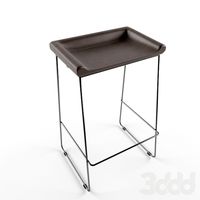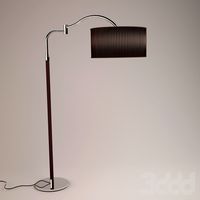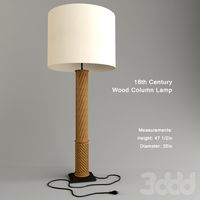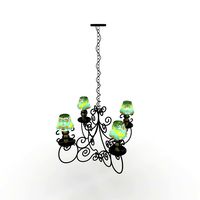3DWarehouse

History of the Sword - Late Iron Age - 1st Century Anthropomorphic Sword - Recreation
by 3DWarehouse
Last crawled date: 1 year, 7 months ago
In archaeology, the Iron Age was the stage in the development of any people in which tools and weapons whose main ingredient was iron were prominent. Like the preceeding Bronze Age, development of this technology varied depending on geographic location. While the Iron Age is considered to have started around 1,300 BCE in the Near East (present day Turkey), and rapidly spread throughout that part of the world, it did not make its' way into Europe until around 1000 BC, probably from Asia Minor where it slowly spread northwards and westwards over the succeeding 500 years. In Central Europe, the Iron Age is generally divided into the early Iron Age Hallstatt culture (HaC and D, 800–450) and the late Iron Age La Tène culture (beginning in 450 BC). The Iron Age ends with the Roman Conquest of the predominently Celtic cultures of Central and Western Europe. This particular sword, from the LaTiene D Culture circa the first century BC. is presently on display in New York City's Metropolitan Museum of Art. it is classified as an anthropomorphic Celtic sword due to the sword hilt's stylized representation of a human figure, a common style during this period. This model depicts this sword as it might have appeared in new condition with it's bronze-copper scabbard. Sword from hilt to point is 19 3/4' (50 cm) in length. #Anthropomorphic #Celtic #Europe #European #Iron #Iron_Age #La_Tiene #Met #Metropolitan_Museum_of_Art #Sword #weapon
Similar models
3dwarehouse
free

History of the Sword - Late Iron Age - 1st Century BC Celtic Anthropomorphic Sword - Style 1
...his period. sword from hilt to point is 19 3/4' (50 cm) in length. #europe #european #iron #iron_age #la_tiene #sword #weapon
3dwarehouse
free

History of the Sword - Late Iron Age - 1st Century Anthropomorphic Sword - Al Massey Reproduction
... latene d swords. for full description, see scene 2 #anthropomorphic #british #del_tin #england #iron_age #la_tene #sword #weapon
3dwarehouse
free

History of the Sword - Late Iron Age - 1st Century Anthropomorphic Sword - Del Tin Reproduction
...orkshire england. for full description, see scene 2 #anthropomorphic #british #del_tin #england #iron_age #la_tene #sword #weapon
3dwarehouse
free

History of the Sword - Late Bronze Age (1,200 BCE) Mycenaean Flange Hilt Swords
...hs of the swords are 26 3/4 inches. #bronze #bronze_age #flange_hilted #greek #greese #mycanae #mycanaean #sword #warrior #weapon
3dwarehouse
free

History of the Sword - Late Iron Age - 1st Century Anthropomorphic Sword - Al Massey Reproduction 2
...m. for full description, see scene 2. #al_massey #anthropomorphic #iron_age #italian #italy #jake_powning #la_tene #sword #weapon
3dwarehouse
free

History of the Sword - Middle Bronze Age (1,300 BCE) - British Rapier
...british isles around 1,300 bce. overall length = 20 3/8 inches #british_isles #bronze #bronze_age #england #rapier #sword #weapon
3dwarehouse
free

History of the Sword - Late Bronze Age (1,200 BCE) Mycenaean Flange Hilt Short Sword - Version 1
...erall length of swords = 17 inches. #bronze #bronze_age #flange_hilted #greek #greese #mycanae #mycanaean #sword #warrior #weapon
3dwarehouse
free

History of the Sword - Late Bronze Age (1,200 BCE) Mycenaean Flange Hilt Short Sword - Version 2
...l length of swords = 17 1/8 inches. #bronze #bronze_age #flange_hilted #greek #greese #mycanae #mycanaean #sword #warrior #weapon
3dwarehouse
free

History of the Sword - Late Bronze Age (800-700 BCE) - British Ewart-ParK Sword
...67cm). #british_isles #bronze #bronze_age #england #ewart_park #founders_hoard #hoard #leaf_blade #slash #slashing #sword #weapon
3dwarehouse
free

History of the Sword - Mid Bronze Age Penard Phase (1,200-1000 BCE) - Irish Ballintober Sword
...tish_isles #bronze #bronze_age #england #founders_hoard #hoard #ireland #leaf_blade #panard_phase #slash #slashing #sword #weapon
Anthropomorphic
turbosquid
$59

anthropomorphic elephant
...lty free 3d model anthropomorphic elephant for download as ma on turbosquid: 3d models for games, architecture, videos. (1238456)
turbosquid
$60

Anthropomorphous jar
... available on turbo squid, the world's leading provider of digital 3d models for visualization, films, television, and games.
3d_export
$30

Cute anthropomorphic robot
...a cute robot is suitable as an assistant character or bot guide. he can act as a butler, janitor or protector/nanny for children.
3d_export
free

Low poly anthropomorphic wolf
...w poly anthropomorphic wolf
3dexport
hand paint textures, emisive map for eyes. if you need something like it i can work for you
turbosquid
$5

HIGHT POLY character of an anthropomorphic fish made in zbrush does not include textures
...ish made in zbrush does not include textures for download as on turbosquid: 3d models for games, architecture, videos. (1672658)
3d_export
$10

robot wrist
...robot wrist 3dexport anthropomorphic robot...
3d_export
$10

whisky
...whisky
3dexport
this model is an anthropomorphous dog with style of sketch but in 3d.
3d_export
$5

Blank for creating a robot
...a blank for creating a female robot, or an anthropomorphic ...
3d_export
$10

tom low-poly
...challenges and communal content creation projects.<br>tom is a blue/grey anthropomorphic domestic short-haired cat who first appeared in the 1940...
3ddd
$1

BILLY BL TABLE LAMP
...the ilse crawford edition, billy tl’s honest construction and anthropomorphic quality are as apparent as ever, but now the...
Late
3ddd
$1

Late
... барный
барный стул отсюдаhttp://www.danish-store.ru/collections/chairs/products/late?variant=890643065
turbosquid
$400

Late Triassic Earth
... available on turbo squid, the world's leading provider of digital 3d models for visualization, films, television, and games.
turbosquid
$400

Late Ordovician Earth
... available on turbo squid, the world's leading provider of digital 3d models for visualization, films, television, and games.
turbosquid
free

Late Model Wings
... available on turbo squid, the world's leading provider of digital 3d models for visualization, films, television, and games.
3d_ocean
$9

Clear Late Afternoon
...d a vertical cross version. spherical map has a resolution: 5000×2500 px. light probe resolution: 3000×3000 px vertical cross ...
cg_studio
$99

Tiger - Late Production3d model
...gstudio
.lwo .c4d .3ds .obj - tiger - late production 3d model, royalty free license available, instant download after purchase.
turbosquid
$99

iMac Late 2012 Station
... available on turbo squid, the world's leading provider of digital 3d models for visualization, films, television, and games.
turbosquid
$3

late hours dress 03
... available on turbo squid, the world's leading provider of digital 3d models for visualization, films, television, and games.
turbosquid
$3

late hours dress 02
... available on turbo squid, the world's leading provider of digital 3d models for visualization, films, television, and games.
turbosquid
$39

Knight's Bastard Sword, Late Medieval PBR
... available on turbo squid, the world's leading provider of digital 3d models for visualization, films, television, and games.
1St
turbosquid
$19

Toyota 1ST
... available on turbo squid, the world's leading provider of digital 3d models for visualization, films, television, and games.
turbosquid
$7

Stone (Big - 1st)
...el stone (big - 1st) for download as 3ds, obj, fbx, and blend on turbosquid: 3d models for games, architecture, videos. (1415222)
turbosquid
$30

1ST INFANTRY DIVISION
... available on turbo squid, the world's leading provider of digital 3d models for visualization, films, television, and games.
turbosquid
$15

oiler (1st part)
... available on turbo squid, the world's leading provider of digital 3d models for visualization, films, television, and games.
turbosquid
$10

1st Place Trophy
... available on turbo squid, the world's leading provider of digital 3d models for visualization, films, television, and games.
turbosquid
$4

1ST ID LRSD
... available on turbo squid, the world's leading provider of digital 3d models for visualization, films, television, and games.
turbosquid
$4

1st place medal
... available on turbo squid, the world's leading provider of digital 3d models for visualization, films, television, and games.
turbosquid
$60

Sci-Fi 1st Person
...
royalty free 3d model sci-fi 1st person for download as fbx on turbosquid: 3d models for games, architecture, videos. (1210363)
turbosquid
$15

Capacity for food (1st part)
... available on turbo squid, the world's leading provider of digital 3d models for visualization, films, television, and games.
3ddd
$1

бра Encased Gems (726950-1st)
...950-1st)
3ddd
encased gems , fine art lamps
бра encased gems (726950-1st)
fine art lamps
Recreation
3d_export
$5

Recreation area
...recreation area
3dexport
my very first design of a recreation area with panoramic windows.
3d_export
$7

recreation room
...rt
recreation room can be an impressive element for your projects. easy to use, realistic image, low polygon, quality materials.
turbosquid
$34

Recreation center
... 3d model recreation center for download as 3ds, max, and fbx on turbosquid: 3d models for games, architecture, videos. (1462912)
3d_export
$10

childrens recreation room
...childrens recreation room
3dexport
children's recreation room
turbosquid
$150

RECREATIONAL BOAT
... available on turbo squid, the world's leading provider of digital 3d models for visualization, films, television, and games.
turbosquid
$150

recreational boat5
... available on turbo squid, the world's leading provider of digital 3d models for visualization, films, television, and games.
turbosquid
$5

Marine Recreation Area Marine Recreation Area symbol
... available on turbo squid, the world's leading provider of digital 3d models for visualization, films, television, and games.
3d_export
$65

water recreation
...water recreation
3dexport
simple rendering of the scene file
3d_export
$70

Recreational vehicle 3D Model
...icle 3d model
3dexport
recreational vehicle rv camper caravan travel camping
recreational vehicle 3d model tartino 45168 3dexport
3d_export
$10

modern childrens recreation room
...modern childrens recreation room
3dexport
modern children's recreation room
History
turbosquid
$50

History Church
...alty free 3d model history church for download as max and fbx on turbosquid: 3d models for games, architecture, videos. (1284367)
turbosquid
$50

History Old Building
... model history old building for download as jpg, max, and fbx on turbosquid: 3d models for games, architecture, videos. (1276133)
turbosquid
$50

History old building
...l history old building for download as jpg, tif, max, and fbx on turbosquid: 3d models for games, architecture, videos. (1273146)
turbosquid
$5

Islamic Architecture History
... available on turbo squid, the world's leading provider of digital 3d models for visualization, films, television, and games.
turbosquid
$12

Dishes old history n2
...yalty free 3d model dishes old history n2 for download as max on turbosquid: 3d models for games, architecture, videos. (1575409)
3d_export
$18

history-historic site-tianlufang 12
...history-historic site-tianlufang 12
3dexport
history-historic site-tianlufang 12<br>3ds max 2015
3d_export
$18

history-historic site-tianlufang 13
...history-historic site-tianlufang 13
3dexport
history-historic site-tianlufang 13<br>3ds max 2015
3ddd
$1

Шкаф "History"
...рованс.http://lifemebel.ru/catalog/mebel_dlya_spalni/shkafy_tumby_komody/shkafy/model/stellazh_pearl_style_kfh10034_eg/
turbosquid
$73

Yacht Baia 100 History Supreme
... available on turbo squid, the world's leading provider of digital 3d models for visualization, films, television, and games.
3d_export
$18

ancient-history-book-bamboo slip 01
...1
3dexport
ancient-history-book-bamboo slip 01<br>max 2015 v-ray 3 max 2015<br>textures<br>all files in zip...
Age
3d_export
$245

aging man
...aging man
3dexport
high detailed aging man.<br>poses:<br>aging sequence:<br>faces / verts
3d_export
$30

Aged To Perfection 50 Age Cake
...so order real cake from this link: https://cakesburg.co.uk/products/age-to-perfection-50-cake?_pos=1&_sid=a15854854&_ss=r
3ddd
$1

Aged Pixel.Роter.
... постер
колекция постеров. автор работ aged pixel.http://fineartamerica.com/profiles/agedpixel.html
turbosquid
$10

Aged Chiar
...bosquid
royalty free 3d model aged chiar for download as obj on turbosquid: 3d models for games, architecture, videos. (1358073)
vizpark
$50

Aged Walls
... highly detailed old brick multitextures for architectural visualization, with bump, displacement, reflection and diffuse layers.
turbosquid
$60

Aged vase
...lty free 3d model aged vase for download as max, obj, and fbx on turbosquid: 3d models for games, architecture, videos. (1268812)
3ddd
free

Aran / AGE-LOW
...aran / age-low
3ddd
aran
фабрика aran, коллекция age-low
turbosquid
$49

Aged Couch
... 3d model aged couch for download as blend, dae, fbx, and obj on turbosquid: 3d models for games, architecture, videos. (1527087)
3ddd
$1

NEW AGE Linen Chair
...new age linen chair
3ddd
new age
кресло new age linen chair от curations limited
3ddd
$1

Aged Pixel.Brand Names - Grass
...ddd
aged pixel , картины
колекция постеров.brand names - grass автор работ aged pixel.
Century
3ddd
$1

Century Furniture
.../www.centuryfurniture.com/gallery/showitem.aspx?sku=639-532
century furniture dining room windowpane arm chair 639-532
3d_export
$7

mid century chair
...mid century chair
3dexport
mid-century type dining chair
turbosquid
$10

Century Chair
...free 3d model century chair for download as max, fbx, and obj on turbosquid: 3d models for games, architecture, videos. (1711388)
turbosquid
$20

Century Car
... available on turbo squid, the world's leading provider of digital 3d models for visualization, films, television, and games.
3ddd
$1

Century Furniture Saturn Chair
...century furniture saturn chair
3ddd
century furniture
century furniture saturn chair
3d_export
$65

century avenue
...century avenue
3dexport
simple rendering of the scene file
3ddd
free

Торшер Century Terra
...ra
3ddd
century terra
модель торшера century terra делалась в archicad`е. только провод был добавлен в максе, ну и рендер конечно
3ddd
$1

Стул Century Antiques
...стул century antiques
3ddd
стул фирмы century классический с текстурами и материалами. рендерено в максе+vray.
3ddd
$1

18th Century Wood
...18th century wood
3ddd
lucca antiques
18th century wood column lamp
measurements:
height: 47 1/2in
diameter: 20in
3ddd
free

Комод Century furniture
...а: century furniture
модель: chinese credenza
артикул: 609-403
ширина: 198 см
высота: 89,5 см
глубина: 59 см
в архиве 3dsmax 2010
Sword
3d_ocean
$3

sword
...sword
3docean
sword
a high quality sword .
3d_export
$5

sword
...sword
3dexport
a sword made in a blender, a quality sword
3d_export
$35

Sword
...sword
3dexport
sword
3d_export
$10

sword
...sword
3dexport
sword
3d_export
$6

sword
...sword
3dexport
sword
3d_export
$5

sword
...sword
3dexport
sword
3d_export
$5

sword
...sword
3dexport
sword
3d_export
$5

Sword
...sword
3dexport
sword
3d_export
$5

sword
...sword
3dexport
sword
3d_export
$5

sword
...sword
3dexport
sword
Iron
archibase_planet
free

Iron
...ase planet
iron flatiron flat iron smoothing-iron
iron scarlett sc1133s n260112 - 3d model (*.3ds) for interior 3d visualization.
archibase_planet
free

Iron
...et
iron flatiron flat iron smoothing-iron
iron black & decker n131213 - 3d model (*.gsm+*.3ds) for interior 3d visualization.
3ddd
free

Iron
...mbo-unlimitedideas.com/produtos_post/iron-console/
в архиве сцена 2011 и 2014, fbx и obj, текстуры
рендер: vray 2.4
3d_ocean
$15

Steam iron
...ign made by me. you can use it for your projects and games as you want. iron, steam iron, philips,siemens, clothes,ironing, tefal
turbosquid
$8

Iron Chandelier - Iron Chandelier
... available on turbo squid, the world's leading provider of digital 3d models for visualization, films, television, and games.
turbosquid
$35

iron
...on
turbosquid
royalty free 3d model iron for download as max on turbosquid: 3d models for games, architecture, videos. (1365250)
3d_export
$20

iron press
...iron press
3dexport
iron press
3d_export
$5

old iron
...old iron
3dexport
old iron
3d_export
free

iron man
...iron man
3dexport
iron man
3d_export
$49

Iron Giant
...iron giant
3dexport
iron giant film
